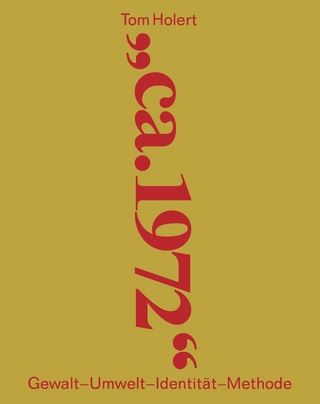
The Age of Interconnection
A Global History of the Second Half of the Twentieth Century
Seiten
2023
Oxford University Press Inc (Verlag)
978-0-19-091895-8 (ISBN)
Oxford University Press Inc (Verlag)
978-0-19-091895-8 (ISBN)
A monumental and accessible global history of the second half of the twentieth century, from the end of World War Two to the terrorist attack on the Twin Towers, offering readers the most complete portrait of the age available.
A panoramic view of global history from the end of World War Two to the dawn of the new millennium, and a portrait of an age of unprecedented transformation.
In this ambitious, groundbreaking, and sweeping work, Jonathan Sperber guides readers through six decades of global history, from the end of World War Two to the onset of the new millennium. As Sperber's immersive and propulsive book reveals, the defining quality of these decades involved the rising and unstoppable flow of people, goods, capital, and ideas across boundaries, continents, and oceans, creating prosperity in some parts of the world, destitution in others, increasing a sense of collective responsibility while also reinforcing nationalism and xenophobia. It was an age of transformation in every realm of human existence: from relations with nature to relations between and among nations, superpowers to emerging states; from the forms of production to the foundations of religious faith. These changes took place on an unprecedentedly global scale. The world both developed and contracted. Most of all, it became interconnected.
To make sense of it, Sperber illuminates the central trends and crucial developments across a wide variety of topics, adopting a chronology that divides the era into three distinct periods: the postwar, from 1945 through 1966, which retained many elements of period of world wars; the upheaval of the 1960s and 1970s, when the pillars of the postwar world were undermined; and the two decades at the end of the millennium, when new structures were developed, structures that form the basis of today's world, even as the iconic World Trade Center was reduced by terrorism to rubble. The Age of Interconnection is a clear-eyed portrait of an age of blinding change.
A panoramic view of global history from the end of World War Two to the dawn of the new millennium, and a portrait of an age of unprecedented transformation.
In this ambitious, groundbreaking, and sweeping work, Jonathan Sperber guides readers through six decades of global history, from the end of World War Two to the onset of the new millennium. As Sperber's immersive and propulsive book reveals, the defining quality of these decades involved the rising and unstoppable flow of people, goods, capital, and ideas across boundaries, continents, and oceans, creating prosperity in some parts of the world, destitution in others, increasing a sense of collective responsibility while also reinforcing nationalism and xenophobia. It was an age of transformation in every realm of human existence: from relations with nature to relations between and among nations, superpowers to emerging states; from the forms of production to the foundations of religious faith. These changes took place on an unprecedentedly global scale. The world both developed and contracted. Most of all, it became interconnected.
To make sense of it, Sperber illuminates the central trends and crucial developments across a wide variety of topics, adopting a chronology that divides the era into three distinct periods: the postwar, from 1945 through 1966, which retained many elements of period of world wars; the upheaval of the 1960s and 1970s, when the pillars of the postwar world were undermined; and the two decades at the end of the millennium, when new structures were developed, structures that form the basis of today's world, even as the iconic World Trade Center was reduced by terrorism to rubble. The Age of Interconnection is a clear-eyed portrait of an age of blinding change.
Jonathan Sperber is Curators' Distinguished Professor of History Emeritus at the University of Missouri. His previous book, Karl Marx: A Nineteenth-Century Life, was a New York Times bestseller and a finalist for the 2014 Pulitzer Prize in biography.
Introduction
Part 1: The Material World
Chapter 1: Nature
Chapter 2: Disease
Chapter 3: Technologies
Part 2: Interactions
Chapter 4: Markets
Chapter 5: Migrations
Chapter 6: The Powers
Part 3: Varieties of the Social
Chapter 7: Societies
Chapter 8: Labor
Chapter 9: Leisure
Chapter 10: Consumers
Part 4: Dreams and Nightmares
Chapter 11: Beliefs
Chapter 12: Murder
Chapter 13: Utopias
Epilogue: The Zeroes
Conclusions
Select Bibliography
Index
| Erscheinungsdatum | 01.12.2022 |
|---|---|
| Zusatzinfo | 44 illustrations |
| Verlagsort | New York |
| Sprache | englisch |
| Maße | 221 x 163 mm |
| Gewicht | 1315 g |
| Themenwelt | Sachbuch/Ratgeber ► Geschichte / Politik ► Allgemeines / Lexika |
| Geschichte ► Allgemeine Geschichte ► Zeitgeschichte | |
| ISBN-10 | 0-19-091895-0 / 0190918950 |
| ISBN-13 | 978-0-19-091895-8 / 9780190918958 |
| Zustand | Neuware |
| Haben Sie eine Frage zum Produkt? |
Mehr entdecken
aus dem Bereich
aus dem Bereich
Gewalt, Umwelt, Identität, Methode
Buch | Softcover (2024)
Spector Books OHG (Verlag)
CHF 49,95
der Osten, der Westen, der Zorn und das Glück
Buch | Hardcover (2024)
S. Fischer (Verlag)
CHF 36,40


